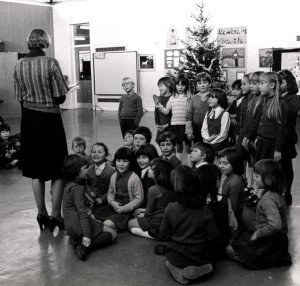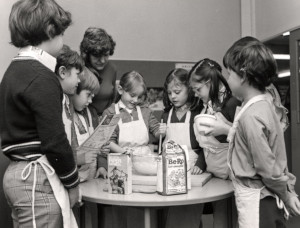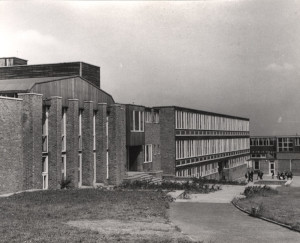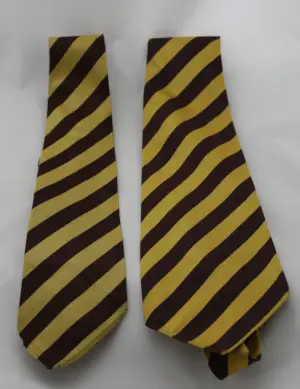School in the 1970s in the UK

Image public domain
What was school like in the 1970s?
The huge upheaval in state education in the UK that started in the 1960s continued in the 1970s.
In 1970, 62% of state school pupils were educated in the tripartite (grammar/technical/secondary modern) system and 31% in comprehensive schools. In 1980, 89% of state school pupils went to comprehensives.
Politicians still debated the merits of the two systems, but time was up for most of the grammars.
There was change in primary education as well. The middle school system, where children were educated at middle schools up to age twleve or thirteen, was introduced by many local authorities. Infants and juniors became first and middle schools.
What was school like in the 1970s compared to today?
Facts about school in the 1970s
- On 1 September 1972 the school leaving age was increased from fifteen to sixteen in the UK
- Pupils took GCE (General Certificate of Education at Ordinary (O-level) or Advanced (A-level)) and/or CSE (Certificate of Secondary Education)
- In 1975 a grading system was introduced for O-levels. Grades A-C were equivalent of the former GCE O-level pass
- The number of pupils getting five or more GCEs or equivalent rose from 22% in 1970/71 to 25% in 1980/81 [1]
- The percentage of UK children at comprehensive (non-selective) schools increased from 31% in 1970 to 89% in 1980
- Free school milk for children over the age of seven ended in 1971
- School milk returned in 1977 for some children under the EEC's School Milk Subsidy Scheme
- Subjects were less gender-specific than in the 1960s
- Corporal punishment was still practised in UK schools in the 1970s
- In some local authorities infants and junior schools were replaced by first and middle schools. Middle schools delayed entry to secondary schools until age twelve or thirteen
At what age did you start school in the 1970s?
School started at age five in the 1970s. Children started school at the beginning of the term in which they had their fifth birthday. They were usually aged four when they first entered the school gates.
What was the school leaving age in the 1970s?
The school leaving age at the start of the 1970s was fifteen. It was raised to sixteen in 1972.
Children were able to leave in the term following their fifteenth or sixteenth birthday. Those old enough were known as 'Easter leavers'. Even after the increase in school leaving age 'Easter leavers' left school with no qualifications.

Image public domain
Types of school
In the 1970s there were primary and secondary schools as there are today. The age range at primary school was five to between eleven and thirteen and at secondary school up to eighteen.
Some primary schools were organised into infants and juniors, as they were in the 1950s and 1960s.
Some education authorities introduced first and middle schools to replace infants and juniors. Middle schools could educate pupils up to age thirteen before transfer to secondary schools. By the end of the 1970s about 20% of pupils at age eleven went to middle schools. The remainder were educated in a system that allowed transfer to the secondary school at age eleven.
After 1972 children stayed at school to age sixteen. Most would have taken some examinations, either GCE O-levels or CSEs (from 1965). Some stayed on at school after sixteen to study GCE A-levels.
Selection at age eleven was disappearing in the 1970s. For many children there was relief at not having to take the dreaded the 11-plus. For some there was disappointment at an opportunity missed.
In some areas the 11+ system persisted. Even in 1980 19% of children were still educated at secondary modern schools and 10% at grammar schools.

Image public domain
How many children went to grammar schools in the 1970s?
This table shows the number of children at each type of school at two dates in the 1970s
| Type | 1970 | 1975 | 1980 |
|---|---|---|---|
| Secondary modern | 41% | 19% | 6% |
| Grammar | 20% | 10% | 4% |
| Technical | 2% | 1% | <0.5% |
| Comprehensive | 31% | 68% | 91% |
| Other | 7% | 3% | 1% |
Derived from figures published in 'Education: historical statistics' by Paul Bolton, House of Commons Library, last updated 27 November 2012
Were comprehensives or grammars better?
I expect it was a case of different strokes for different folks. Some students preferred comprehensives and others would have done better under the selective system.
There was a small rise in the percentage of pupils getting five or more GCE passes from 1970 to 1980.
Subjects/Timetable
Some of the most popular subjects taken at GCE Ordinary Level in the 1970s included:
- English Language
- Mathematics
- English Literature
- Biology
- Geography
- French
- History
- Physics
- Art
- Chemistry
- Economics
- Religious Knowledge
Source:Hansard HC Deb 18 November 1977 vol 939 cc417-9W
School uniform

There was a more relaxed attitude to school uniform in some schools in the 1970s. In others, both comprhensives and grammars, uniform was worn by all pupils. With many secondary moderns disappearing it is possible that more children wore school uniform in the 1970s than did in the 1960s.
Boys usually wore blazers, ties and grey or black trousers. School caps had all but disappeared in state schools.
In some schools girls wore blazers. In others the uniform was a skirt, cardigan, blouse and tie. Girls often wore summer dresses in the summer term.

Discipline and punishments
Corporal punishment was still used in schools in the 1970s.
However, its use was declining. The ILEA (Inner London Education Authority) abolished corporal punishment in their primary schools in 1973.[2]
Detention and lines were also common for lesser offences. Prefects were still allowed to give punishments in many schools.
School milk
Free school milk was available to primary school children at state schools in 1970.
In 1971 the Education Secretary Margaret Thatcher restricted free milk to those under eight years old. She was called 'Thatcher, the milk snatcher'.
Some councils defied the ruling and continue to provide free milk for eight to eleven year olds.
Some sources claim that Shirley Williams, Education Secretary in the following Labour administration, withdrew free milk for all ages. I have found no evidence to support this.
The Labour administration actually extented free school milk with money from the EEC (European Economic Community). The new scheme allowed councils to give milk to children up to eleven and reclaim the money from the government and the EEC.[3]
Many schools used the scheme to re-introduce free milk for the eight to eleven year olds in the 1970s. My school certainly did.
So if you went to school in the 1970s you may remember getting school milk in your youngest years and again just before you left primary school.
Films and TV about schools in the 1970s
- Please Sir! (television series 1968-72)
- Grange Hill (1978-2008)
References
[1] 'Education: historical statistics' by Paul Bolton, House of Commons Library, last updated 27 November 2012, page 19
[2] PROTECTION OF MINORS BILL [H.L.] HL Deb 10 December 1973 vol 347 cc893-965
[3] Hansard: School Milk Volume 946: debated on Tuesday 14 March 1978
Image information
[Image 1] Published as part of the Britain an Official Handbook in 1962 under Crown Copyright. Duration of copyright is fifty years after publication. So this image is public domain.
By Steven Braggs, October 2022


Comments